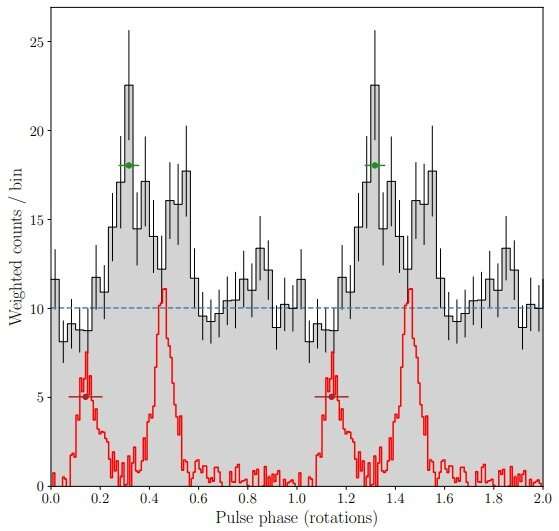June 4, 2019 report
Gamma-ray pulsations detected from the pulsar J0952−0607

An international team of astronomers reports the detection of gamma-ray pulsations from the millisecond pulsar (MSP) known as PSR J0952−0607. The finding, available in a paper published May 27 on arXiv.org, sheds more light on the properties of this pulsar and could be helpful in improving our understanding of MSPs in general.
Pulsars are highly magnetized rotating neutron stars emitting beams of electromagnetic radiation. The most rapidly rotating pulsars, with rotation periods below 30 milliseconds, are known as millisecond pulsars. It is assumed that MSPs are formed in binary systems when the initially more massive component turns into a neutron star that is then spun-up due to accretion of matter from the secondary star.
A class of extreme binary pulsars with semi-degenerate companion stars is dubbed "spider pulsars." These objects are further categorized as "black widows" if the companion has extremely low mass (less than 0.1 solar masses), while if the secondary star is heavier they are called "redbacks."
Discovered in 2017, PSR J0952−0607 is one such black widow. It is a binary radio MSP with a spin frequency of 707 Hz, which makes it the fastest-spinning known pulsar outside of a globular cluster. The companion star in the system has a mass of about 0.02 solar masses and an orbital period of approximately 6.42 hours.
PSR J0952−0607 is very faint in gamma-rays and many of its parameters remain unknown. That is why a group of astronomers led by Lars Nieder of the Max Planck Institute for Gravitational Physics in Hannover, Germany, decided to conduct a very sensitive search for gamma-ray pulsations in this pulsar, based mainly on the analysis of data from NASA's Fermi spacecraft.
Although the challenging investigation required a novel search technique and timing methods with greater sensitivity, it ended in success. Besides the detection of gamma-ray pulsations, the study determined some of the pulsar's parameters with high precision.
"Using a sensitive, fully coherent pulsation search technique, we detected gamma-ray pulsations from the radio pulsar PSR J0952−0607 in a search around the parameters reported by Bassa et al. (2017b)," the researchers wrote in the paper.
According to the study, the gamma-ray pulse profile of PSR J0952−0607 exhibits two peaks separated by approximately 0.2 rotations. Moreover, the phase lag between the gamma-ray and radio pulse profile seems to be around 0.15. These two values are typical for MSPs.
The research found that PSR J0952−0607 has a spin-down rate of approximately less than 4.6 zeptosends per second. This makes it the fastest-spinning pulsar for which that parameter has been reliably constrained.
Furtmermore, the astronomers calculated that the spin-down luminosity of PSR J0952−0607 is at a level of about 64 decillion erg/s. They also found that the strength of its surface magnetic field is relatively low, not greater than 82 million G, which places it among the 10 lowest of all pulsars discovered to date.
Despite the team's effort, some parameters of PSR J0952−0607 are still unknown. Further investigation of this pulsar using Fermi and also the Low-Frequency Array (LOFAR) radio telescope could be much helpful in resolving many of the remaining uncertainties.
More information: L. Nieder et al. Detection and timing of gamma-ray pulsations from the 707-Hz pulsar J0952−0607. arXiv:1905.11352v1 [astro-ph.HE]. arxiv.org/abs/1905.11352
© 2019 Science X Network



















